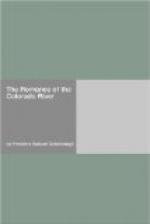* This name, by the way, has no connection with the notorious “Arizona” diamond swindle of more recent years. It bore this name in Ives’s time and the swindle was much later—1872. The alleged diamond field also was not in Arizona at all, but in north-western Colorado.
Soon after leaving this retreat he “halted at the sight of the most profound canones which ever onward continue, and within these flows the Rio Colorado.”
“There is seen [he continues] a very great Sierra which in the distance looks blue, and there runs from the southeast to the north-west a pass open to the very base, as if the sierra were cut artificially to give entrance to the Rio Colorado into these lands. I named this singular pass Puerto de Bucareli,* and though to all appearances would not seem to be great the difficulty of reaching thereunto, I considered this to be impossible in consequence of the difficult canones which intervened. From this position said pass bore east northeast.”
* After the viceroy.
The padre is standing in admiration before the long line of the Kaibab seen as a great sierra from this position on the south-east, and as the land on the south rises toward the rim it probably appeared to him as if the sierra were really a continuation of the San Francisco Mountains on his right, and was cut in twain by the great gorge of the river. From his standpoint he looked up Marble Canyon, and all the directions he mentions are exactly correct. They saw smokes on the north, which his guides said. were made by the Payuches (Pai Utes) living on the other side. The Kaivavitz band of Pai Utes in summer occupy their lands on the summit of the Kaibab, hunting deer and camping in the lovely open glades surrounded by splendid forest. This same day his guides pointed out some tracks of Yabipai Tejua, who go this way to see and trade with their friends, “those who live, as already said, on the other side of the Rio Colorado.” It was one of the intertribal highways. Just where it crossed the canyon is hard to say. There were several old trails, and one came down from the north, reaching the river a few miles below the Little Colorado, but where it came out on the south side I do not know. There was once another trail which came from the north down the canyon of Kanab Creek and found a way across to the Coconinos or Havasupai; at least Jacob Hamblin told me he was so informed by the Pai Utes. The “Hance” trail, I believe, was built on the line of an old native one, and probably this was the one the Yabipais were heading for.
* Jacob Hamblin, whom I knew very well, was the “Leather-stocking” of Utah—a man who knew the Amerinds of Utah and northern Arizona better than any one who ever lived.




